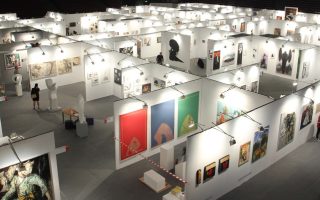Ethereal trees that defy conventional form on Aegina

If there is one thing Anastasis Ioannou remembers from his childhood, it’s his father stuck among his easels of oils and watercolors, wielding a paintbrush or pencil. And there, in the creative chaos of Stavros Ioannis (1945-2009), a renowned expressionist and student of Yannis Moralis, young Anastasis would sit at his own small easel, mimicking his father. And just as all the signs were pointing to him taking a different path to that of his artist parents (his mother, Sissy Vamvaka, was also a painter) and pursuing a career in theoretical physics, which is what he studied at the National Technical University of Athens, Anastasis Ioannou had an epiphany just before embarking on a PhD that blew it all out of the water – or perhaps put everything in its proper place.
This, at least, is what I felt looking at the paintings in his third solo show, currently running at the Aegina History and Folk Art Museum through September 15.
Ioannou works with his trees in the same way that a portraitist may work with a face or a sculpture with a human figure – Giacometti instantly springs to mind
Titled “Into the Trees,” curated by art historian Christoforos Marinos and held in the context of the 15th Aegina Fistiki Fest, it is the artist’s second solo show on the Saronic Gulf island after “Harlequins” in 2020, which is where Ioannou (born 1990) spends part of the year. He also has a home in Athens.
Created within the past two years, his latest series stars trees, as the title suggests, and comes as a kind of informal continuation of the work he showed last year on the nearby island of Hydra.
Ioannou’s oil paintings do not seek the specific or the detail; indeed, the dense foliage of spindly trunked trees often resembles shadow or cloud, fluid shapes that are never completely formed. They do not make us think of the natural world, nor do they intend to.
Ioannou works with his trees in the same way that a portraitist may work with a face or a sculpture with a human figure – Giacometti instantly springs to mind. The fact that he delves so deeply into the subject renders him a tree anatomist. The earth is merely suggested, if that, giving his trees a floating quality or a sense that they have sprung up in the void. And even though there are no human figues to be seen, his paintings are clearly human-centric.
“Elements such as the trunk, the density of the foliage, the empty space, and the use of color as a chromatic field reminiscent of Rothko intensify the metaphysical dimension of my images, creating a liminal space,” the artist argues.
His work also draws connections to the history of Greek painting, to the way that artists like Konstantinos Parthenis, Michalis Oikonomou, Konstantinos Maleas and Nikolaos Lytras depicted the same theme and Greece’s natural elements more generally. Nevertheless, Ioannou identifies more with the visceral art of George Bouzianis than with naturalist and post-impressionist trends. “The ethereal quality of his work could be associated with the ethereal quality of my trees,” the artist says.





